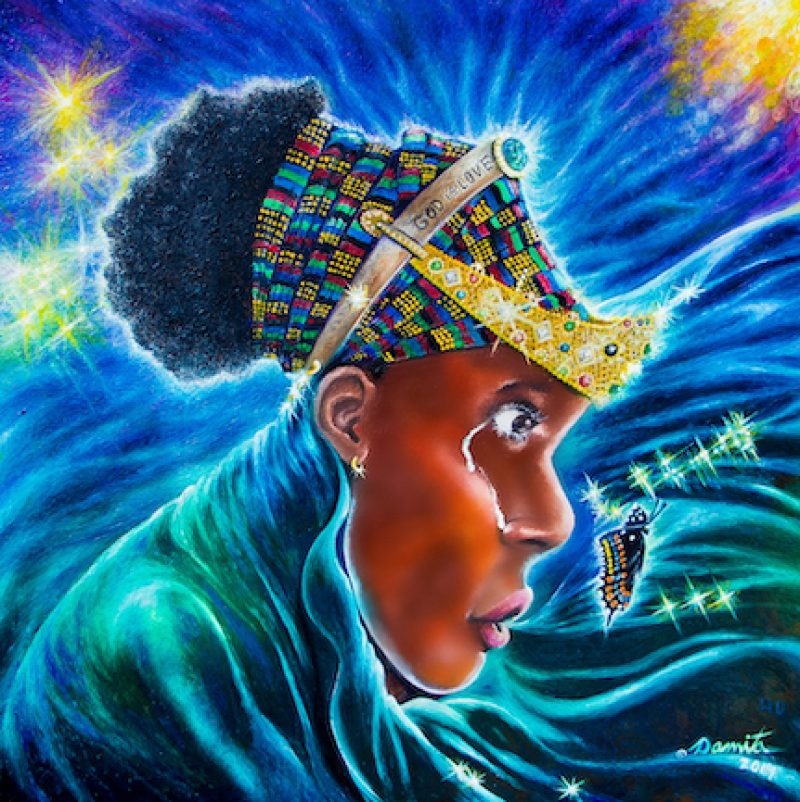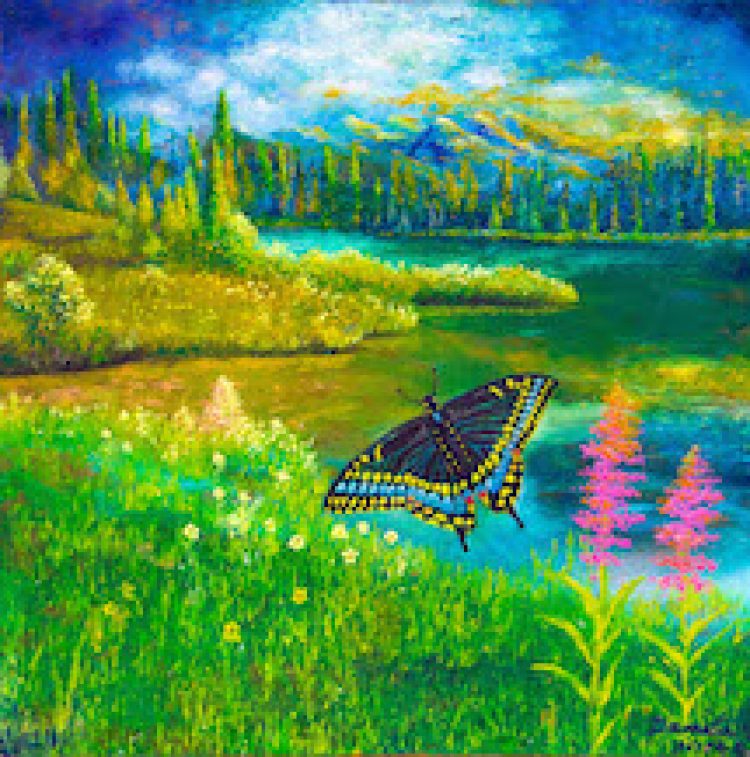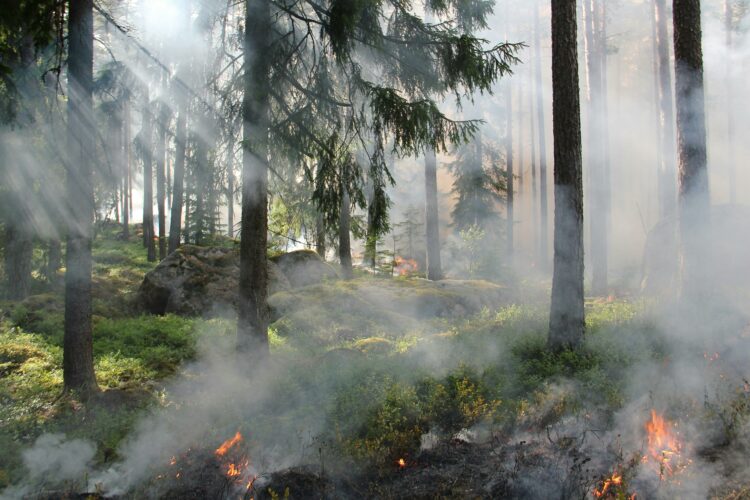Black Butterfly: Interview with Artist Damita Hicks

Damita Hicks is a Bahai artist living in Chapel Hill, North Carolina. Her paintings center on Mama A’free’ca, Nature, and racial unity. Kirsten Bohl of Durham (NC) Friends Meeting speaks with Damita here.
How did you get started with painting?
I’ve been painting almost all my life. In terms of being serious about it, specifically crayon art, something happened when I was in college. My mother made me go. I had just turned 17. I wasn’t taking it seriously. I should have been in class. Instead, I was in the food court. There was a young man sitting at a table. We started to have a conversation. He asked me about myself. I said I did art. He said, “I like the kind you can feel.” He was blind. I saw the cane. I felt so bad. Wow, he can’t enjoy my art. I prayed with all my soul for a way I could paint or do pictures that anyone could see, sighted or not. The thought of crayon came to me. In third grade, I learned crayons are made of wax. So I started working with crayons, layers of wax. That’s how it developed. I call it Crayon Hicks, after my father’s last name.
What is your process (both artistically and spiritually)?
I have never seen anyone do it the way I do. It’s not something I can teach. Literally, I look at a painting and say, How did I do that? As God shows me, I do it. It’s such a spiritual thing. It’s sort of like encaustics, but it’s a whole different process for me. It’s my own way of doing it.
What message do you hope to share with the world?
Unity, everyone coming together, to stop the racialized madness going on. Realize we all come from one Creator and we’re all connected. We’re basically all cousins. We’re all 99.9% the same. That one little bit of a percentage, makes each of us unique individuals. That’s across the world, no matter what color you are, we’re the same 99.9%.
How does your faith inform your art?
I just feel like God is my friend. I just feel that love. That just really gives me a love for all people. The hope I desire for all people, is that we do unite, that we do have that understanding of our connectedness. I want peace for the world. I know it’s a little cliched. We could easily go down another road. In many ways, we are in such a negative trajectory. I just want that to be reversed. I just want people to understand we’re all one.
What have you learned while doing this work?
I learned there is a cry going out amongst people. They’re doing it in different ways. There’s a cry for unity. There’s a cry for equality. The painting Mama A’free’ca made me research the scientific evidence. Everyone came from this one place, Africa. I was surprised. It makes me want to tell the world the truth. Also I see the emotions of people when they see the paintings or hear my presentation. I am encouraged by the comments people make. They say, “The world needs to see this.” I have learned a lot about other people and myself. I’ve learned not to be shy, to speak out and share the word with people.
What brings you the most joy?
Seeing people happy when they see my artwork, or seeing the emotions and seeing the interest of children. They love to touch the paintings because of the texture. I love seeing their joy. Most paintings people see are hands-off. But because of how this came to me – whether you’re looking at it with the brightness of colors, or touching it, I love seeing people happy about my work.
What are the growing edges for you?
I would say I’ve kind of grown into the person of Mamita, which I nicknamed myself. It’s because I feel love for everyone. When I talk to my six children, when I want them to understand and know something is important, I want them to know it’s from love. I’m not shy. I say it boldly, with care and concern. I feel everyone is like my children, and the message I’m giving: You need to hear this. This is so important for you. I feel like I’ve grown in that way.
Also, with writing; I had to grow. Also, with collaboration; being open to others’ ideas. Being firm in where I stand yet open to people giving me feedback and sharing what I learned.
How do you see evidence of God’s hand in Creation?
I usually go back to Mama A’free’ca and my presentation. When I did the painting, I started in about 2013, finished in 2014. Some years later, in 2018 or 2019, I saw the image of the Hubble telescope of a cloud of gases and stars, where stars are being born. The image matches the face of Mama A’free’ca. I measured the proportions in the details. It was the same.
Just seeing, when I look at the stars, the universe, the nebula of space, I do see things. I see things that match, what I know on the earth. Just in everyday life, I see God’s hand working. In me and my daughter. She’s helping me with my video. I could not have done it without her. The skills she’s learned. How God works things out so beautifully, when we pray together. In my family, the evidences of God are all around and I’m just so grateful.
If you wished to move people to action by seeing your paintings, what actions might they take as a result?
To see the nobility of all people, especially the most marginalized and oppressed people, which are Black people around the world, and just see that we are all connected. To stop racist discrimination and negative labels and violence, and to work together in a unified way. The racial construct was made up. To begin teaching the truth of history, who we all are and where we all came from. Not feeling ashamed, feeling like it’s something shameful to be Black or from Africa, to see the beauty in all people.
To change the way we’re taught in school, so the inventions of Black people are included on a daily basis, rather than just one month of the year. So many important inventions to all of us, like the color monitor for the personal computer, the USB port, the refrigeration system for trucking so we can eat fruit at all times of the year, the portable cell phone, the ability to interface with other computers on the internet, improvements in heart surgery, blood transfusions, the invention of Lasik eye surgery, fiber optics, and so many more!
Lots of people’s contributions who are African descended have not been really taught or shown, so our society doesn’t really celebrate them. That change, so the quality of our education will benefit everyone. It will give our children the heroes they need, especially Black children, so school becomes a place they enjoy going. However we’re learning, whether online or in an actual school, so everyone is included and we have the right understanding of who our people are. Nobility. Empathizing with the plight of people who are suffering under the white supremacist system. Looking with wisdom, looking deeper into the situation with sagacity, so we can make the necessary changes.
What is one way you connect with Nature in your own home?
I’m trying to learn how to have a green thumb. I have houseplants. I love having plants because they clean the air and give off oxygen. I’m giving them something and they’re giving me something. I’m gaining more knowledge about how to grow plants, bringing plants into my home.
Where does your own relationship with Nature begin?
I just realize how important Nature is. Even the Bible says, Pay attention to the ant. There is so much we can learn from how they work together. I just love the colors of Nature, the beauty of Nature. I’m looking at my painting of the hummingbird right now. Just the way they pollinate the flowers. We wouldn’t have the food we have without them and the bees. I am wary of biting bugs, but a lot of nature is so beautiful. If you look outside with the trees, that energy is so fascinating, what it’s doing. Connecting with Nature and learning about it is fascinating to me.
There is a stereotype that Black men and women do not enjoy or embrace Nature. Your paintings tell a different story. Can you speak to that?
We’ve been in crowded conditions. When you think about slavery and after that, the ghetto areas or tenement areas. These were the projects. They were constructed based on studies of rats. They saw how rats would fight against one another. They would fight against one another in small, compartmentalized, crowded spaces. It’s sad. Knowing the effect it would have on people, it was planned out that way. That’s one part of it.
Another part of it, in slavery times, Black people were not allowed to congregate. They would be beaten. Even in a secluded spot in Nature, to get away, relax, and come together in a church service setting, they would be beaten, punished, severely chastised. That’s something they were not allowed to do freely. Also, there were lynchings and things like that. A lot of negative things that happened. So Nature didn’t feel safe.
Also, there was racism even in the parks. Black people were going, but when they saw there were so many Black people going, they put on restrictions. It was not so friendly or accessible.
When you think about Nature, African people know about herbs and are able to work the land. That’s such a big part of who we are as African based people. Like Dr. Carver, George Washington Carver. He talked to the plants. He was called the Savior of the South. He knew about crop rotation. He saved the land, so it was not depleted of nutrients. He taught people about that. It is a natural part of us, but we just hadn’t had the opportunities, weren’t able to grow up in Nature, except maybe working land for somebody else. After slavery, indentured servitude, share cropping. Being cheated out of the monies. When I talked to people, parents and grandparents, they said, “It was basically slavery all over again.”
Lots of people moved to the city to feel more free, to have more control over their own destiny. There are a lot of factors that made Nature a more scary thing, rather than a thing of beauty. Some people have begun to reconnect with Nature. It’s taking a while for Black people to reconnect, but we’re beginning to.
You have a painting called Black Butterfly. Please tell me about it.
There’s a song called “Black Butterfly.” I really connected with it. It’s by Denise Williams. It’s talking about bringing out the awareness of people, the beauty of who we are. It says so many things. Coming out of slavery or the slave mentality, feeling less than, inferior. Showing people the true beauty of who we are, as the Black Butterfly.
Black Butterfly in my painting represents the people; in the diaspora, people were taken forcibly from their land to be enslaved. Also, people who are marginalized and who feel the oppression of white supremacist ideas. In my painting of Mama A’free’ca, I saw how the shape of Madagascar, looked like a butterfly. So I painted it as a butterfly. Coming out of the chrysalis, showing the beauty of our people, showing a new way. People are made to feel not beautiful, ugly, for having color – how God made us. To come out of that, emerge, feel proud and noble. Feel freedom of the butterfly. Having wings to fly.
How is Madagascar significant for you?
I found out [that] one of my great-great [grandmothers] (how many greats?) was taken over there in the time of the slave trade. I don’t know if it’s called the Gate of No Return. They took them over there, to demoralize them, get them ready to be taken away and become slaves. It was a place where, sort of like a dungeon, jail, or prison. Dark, cold, and damp. Harsh conditions, awaiting to be chained in the very unhealthy state of being enslaved. People would go to purchase slaves. Having the connection of my maternal ancestor going through that – I don’t know the full history of every one of my ancestors, but she is one that I do know about.
Where do you live? Who is in your family?
I live in Chapel Hill, North Carolina. I am married and I have six children. All my children are doing great.
How many paintings are there?
There are over 50-something paintings.
How can people view the paintings?
My presentation on video will be available soon. As things open up, I will continue to do art presentations on “Racial Healing and Unity.”
Please contact Damita at damitajhicks@gmail.com if you would like to purchase her artwork, host an exhibit, or schedule a workshop.
Watch her video, SAY ALL THINGS ARE OF GOD! Most Amazing Crayon Art for Racial Healing, here.


